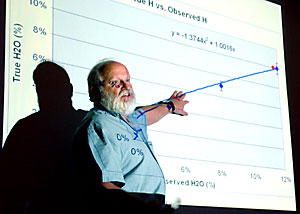 |
|
David Harden/Arizona Daily Wildcat
|
Lunar and planetary sciences professor William Boynton describes slides during a conference in the Lunar and Planetary Sciences Laboratory. The UA could be one of many key players in President Bush's future plans for Mars and lunar exploration.
|
|
|
By Jessica Lee
Arizona Daily Wildcat
Thursday, January 15, 2004
Print this
UA researchers are hoping they can cash in on President Bush's new space initiative that aims to establish a base on the moon and send people to Mars.
Scientists across campus said yesterday that Bush's vision for human exploration in outer space could generate research grants for a variety of campus departments.
"This plan will be very positive for the UA. We are well-positioned in a number of fields. We have experts on both the moon and Mars, and have had a larger role in planning moon and Mars activities," said Michael Drake, director of the UA Lunar and Planetary Laboratory.
Researchers at the UA have already gotten involved in space exploration. In March 2001, they helped find water on Mars. Over the summer, NASA awarded the UA its largest grant ever, $325 million, to help search for life on Mars.
Drake said he expects research and funding to flow not only to planetary and lunar sciences but also to other departments.
For example, establishing permanency in space will require research in the College of Medicine in order to learn how to keep humans healthy in a space environment.
Drake cited another example of how faculty in the College of Agriculture and the College of Engineering could research how to grow food in space.
"Unlike Antarctica, we cannot fly in or ship supplies to the moon," Drake said.
Mark Sykes, a UA astronomer and assistant director of the Tucson-based Planetary Science Institute, said he also believes the UA will benefit financially from the new space focus.
"The devil will be in the details. We are talking about the reallocation of billions of dollars within the current NASA budget. The UA will probably benefit from this initiative, most likely from the large amount of expertise in those areas at the UA," said Sykes, who worked on former President George H. W. Bush's space exploration initiative.
Sykes said he is excited by the proposal, but he is also a little skeptical because of his previous experience.
"It was found when we got into the details; the initiative was an expensive proposition. The problems I have is: If what you want is just to have a presence in space, a place to plant a flag, then we would be spending a lot of money," Sykes said. "If we want economic activity and human expansion, a lot of homework has been ignored in these goals."
Drake said he is excited that Bush wants to reinvest in space exploration.
"Personally, I have long felt that one of the reasons we have a space program is because Americans like to see Americans do interesting things in space. Our culture is epitomized by "Star Wars" and "Star Trek," by the yearning of not to be alone in space," Drake said.
But Drake cautioned that Bush's announcement would not mean instant money for anyone, including UA researchers.
Drake said it would take more than one year before any funding would be ready to be distributed, as the president will propose the endeavor as part of the fiscal year 2005 budget.
It would then be up to Congress to decide how much money NASA receives, he said.
Once NASA decides how to implement the initiative, universities will be able to send in proposals.
The news of more possible Mars and lunar funding comes less than six months after NASA awarded the UA a $325 million grant to explore for life on Mars.
The "Phoenix" mission will explore frozen water and molecules just beneath the surface of the planet. The existence of Martian water may lead to evidence of life.
"Phoenix may actually turn up the smoking gun on Mars," Drake said.
Peter Smith, a UA senior research scientist at the Lunar and Planetary Laboratory, is involved in the NASA Mars Exploration Rover Mission, led by the Jet Propulsion Laboratory in Pasadena, Calif.
The rover "Spirit" is predicted to drive off its landing pad as early as this morning. The vehicle will study the surface of Mars for three months.
President Bush announced yesterday, at a press conference at NASA headquarters, that he wants to establish a base on the moon by 2020.
He also hopes to eventually send people to Mars. He pledged to invest $12 billion in the new space initiative over the next five years.
